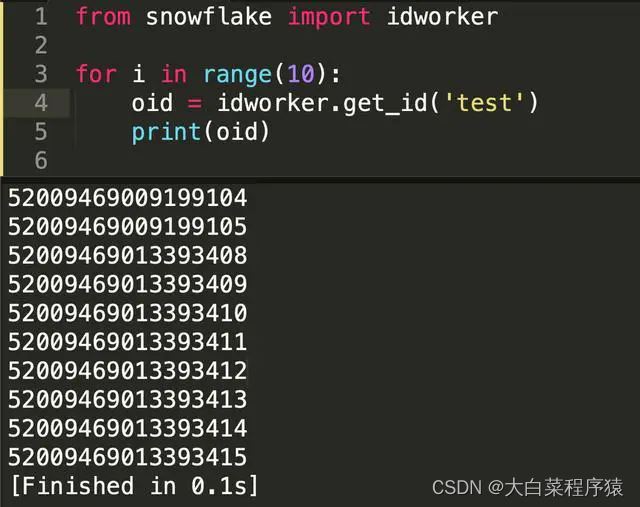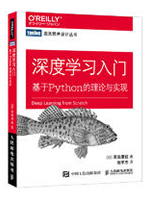为找教程的网友们整理了相关的编程文章,网友司语燕根据主题投稿了本篇教程内容,涉及到python、生成唯一id、python、唯一id、python 生成唯一id相关内容,已被808网友关注,下面的电子资料对本篇知识点有更加详尽的解释。
python 生成唯一id
1.使用UUID
- UUID应该是大家耳熟能详的一个东西了,它的全称叫 通用唯一识别码(英語:Universally Unique Identifier,缩写:UUID)
- 生成标准32位uuid
import shortuuid
import uuid
# 生成一个标准格式32位UUID,参数为位数
def new_uuid(length=None):
if length is None:
return str(uuid.uuid1())
else:
return str(shortuuid.ShortUUID().random(length=length))
标准uuid
import uuid uid = uuid.uuid1() print(uid) print(uid.hex)
2.mongodb的ObjectId
相信使用过mongodb的朋友们很清楚,它的文档默认的key其实也是一个uuid,所以我们也可以利用mongodb的ObjectId来产生一个UUID
import bson demoid = bson.ObjectId()print(demoid)
总结:UUID/ObjectID
优点: 本机生成,效率高,全局唯一性,通用标准。
缺点:不利于存储,在Mysql的InnoDB引擎下做索引很影响效率,不利于海量数据查询。
3.雪花算法 Snowflake
twitter(推特)前些年把自己的唯一ID生成算法开源了,也叫做雪花算法,取自(世界上没有一片相同的雪花)
pysnowflake 库安装
pip install pysnowflake -i https://pypi.tuna.tsinghua.edu.cn/simple/
# Importing the `snowflake.client` module. import snowflake.client # Calling the `get_guid()` function from the `snowflake.client` module. uuid = snowflake.client.get_guid() # Printing the value of the `uuid` variable. print(uuid) # Printing the binary representation of the `uuid` variable. print(bin(uuid)) # 4674877370191056897 # 0b100000011100000100000000011001100011010110000000001000000000001

优点: 不依赖第三方系统,ID全局唯一,数据具有递增的连续性,便于查询。
缺点:依赖系统时钟,如果系统时钟有问题,会导致ID重复(该问题可以通过很多方式避免)
4.时间戳id
4.1、获取秒级时间戳与毫秒级时间戳、微秒级时间戳
import time import datetime t = time.time() print (t) #原始时间数据 print (int(t)) #秒级时间戳 print (int(round(t * 1000))) #毫秒级时间戳 print (int(round(t * 1000000))) #微秒级时间戳
返回
1499825149.257892 #原始时间数据
1499825149 #秒级时间戳,10位
1499825149257 #毫秒级时间戳,13位
1499825149257892 #微秒级时间戳,16位
4.2 获取当前日期时间
dt = datetime.datetime.now().strftime('%Y-%m-%d %H:%M:%S')
dt_ms = datetime.datetime.now().strftime('%Y-%m-%d %H:%M:%S.%f') # 含微秒的日期时间,来源 比特量化
print(dt)
print(dt_ms)
返回
2018-09-06 21:54:46
2018-09-06 21:54:46.205213
4.3 将日期转为秒级时间戳
dt = '2018-01-01 10:40:30' ts = int(time.mktime(time.strptime(dt, "%Y-%m-%d %H:%M:%S"))) print (ts)
返回
1514774430
4.4 UTC时间
dt2 = '2023-02-04T02:12:05.047Z'
dt = dt2[0:19].replace('T', ' ')
ts = int(time.mktime(time.strptime(dt, "%Y-%m-%d %H:%M:%S")))
返回
1675447925
4.5 将秒级时间戳转为日期
ts = 1515774430
dt = time.strftime("%Y-%m-%d %H:%M:%S", time.localtime(ts))
print(dt)
返回
2018-01-13 00:27:10
4.6 时间格式转成另一种时间格式
dt = '08/02/2019 01:00'
dt_new = datetime.datetime.strptime(dt, '%m/%d/%Y %H:%M').strftime('%Y-%m-%d %H:%M:%S')
print(dt_new)
返回
2019-08-02 01:00:00
4.7 转结构体时间struct_time
ta_dt = time.strptime("2018-09-06 21:54:46", '%Y-%m-%d %H:%M:%S') #日期时间转结构体
ta_ms = time.localtime(1486188476) #时间戳转结构体,注意时间戳要求为int,来源 比特量化
print(ta_dt)
print(ta_ms)
返回
time.struct_time(tm_year=2018, tm_mon=9, tm_mday=6, tm_hour=21, tm_min=54, tm_sec=46, tm_wday=3, tm_yday=249, tm_isdst=-1)
time.struct_time(tm_year=2017, tm_mon=2, tm_mday=4, tm_hour=14, tm_min=7, tm_sec=56, tm_wday=5, tm_yday=35, tm_isdst=0)
4.8 python获取纳秒级时间戳方法(19位)
import time print(time.time_ns())
返回
1600251903664616300
到此这篇关于python 生成唯一id的四种方式的文章就介绍到这了,更多相关python 生成唯一id内容请搜索码农之家以前的文章或继续浏览下面的相关文章希望大家以后多多支持码农之家!



















